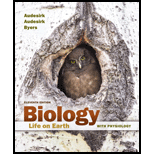
Concept explainers
Unwelcome Dinner Guests
How do harmful bacteria get into our food? Marty foodborne illnesses result from consumption of contaminated beef. The intestinal tracts of about a third or the cattle in the United States carry bacteria that are harmful to humans, and these bacteria can be transmitted to humans when a meatpacker accidentally grinds some gut contents into hamburger. Similarly, chicken feces may splash onto eggs, setting the stage for harmful bacteria to enter the eggs through tiny cracks or when the consumer breaks the egg and its contents contact the shell. Produce such as lettuce, spinach, tomatoes, and melons can also become contaminated if farm fields are exposed to animal feces, which can be deposited by deer or wandering domestic animals or carried from nearby ranches and feedlots in dust or runoff. The warm, moist environments in which sprouts are grown provide excellent growing conditions for any harmful bacteria that may have been present on the seeds from which the sprouts were produced.
How can you protect yourself from the bacteria that share our food supply? It's easy: Clean, cook, and chill. Cleaning helps prevent the spread or pathogens. Wash your hands before preparing food, and wash all utensils and cutting boards after preparing each item. Thorough cooking is the best way to ensure that any bacteria present in food are killed. Meats, in particular, must be thoroughly cooked; food safety experts recommend using a meat thermometer to ensure that the thickest part of cooked pork or ground beef has reached 16CTF. The safe temperature for cuts or beef, veal, or lamb is 145°F; for all poultry, 165°F. The color or cooked meat can be an unreliable indicator of safety, but when a meat thermometer is unavailable, try to avoid eating meat that is still pink inside, especially ground beef. Fish should be cooked until it is opaque and flakes easily with a fork; cook eggs until both white and yolk are firm. Finally, keep stored food cold. Pathogens multiply most rapidly at temperatures between 4CT and 140CF. So get your groceries home from the store and into the refrigerator or freezer as quickly as possible. Don’t leave cooked leftovers unrefrigerated for more than 2 hours. Thaw frozen foods in the refrigerator or the microwave, not at room temperature. A little bit of attention to food safety can save you from unwelcome guests in your food.
CONSIDER THIS Consumer groups contend that we can improve food safety by giving government agencies additional funding and greater authority to inspect rood processing plants and order recalls of contaminated food. Opponents or such steps argue that we need not empower government agencies because the best protection against rood contamination is informed consumers, who will stop buying products from companies that have produced unsafe foods. Would you support or oppose additional government oversight of food safety?
Want to see the full answer?
Check out a sample textbook solution
Chapter 20 Solutions
Biology: Life on Earth with Physiology (11th Edition)
- 12. Calculate the area of a circle which has a radius of 1200 μm. Give your answer in mm² in scientific notation with the correct number of significant figures.arrow_forwardDescribe the image quality of the B.megaterium at 1000X before adding oil? What does adding oil do to the quality of the image?arrow_forwardWhich of the follwowing cells from this lab do you expect to have a nucleus and why or why not? Ceratium, Bacillus megaterium and Cheek epithelial cells?arrow_forward
- 14. If you determine there to be debris on your ocular lens, explain what is the best way to clean it off without damaging the lens?arrow_forward11. Write a simple formula for converting mm to μm when the number of mm's is known. Use the variable X to represent the number of mm's in your formula.arrow_forward13. When a smear containing cells is dried, the cells shrink due to the loss of water. What technique could you use to visualize and measure living cells without heat-fixing them? Hint: you did this technique in part I.arrow_forward
- 10. Write a simple formula for converting μm to mm when the number of μm's are known. Use the variable X to represent the number of um's in your formula.arrow_forward8. How many μm² is in one cm²; express the result in scientific notation. Show your calculations. 1 cm = 10 mm; 1 mm = 1000 μmarrow_forwardFind the dental formula and enter it in the following format: I3/3 C1/1 P4/4 M2/3 = 42 (this is not the correct number, just the correct format) Please be aware: the upper jaw is intact (all teeth are present). The bottom jaw/mandible is not intact. The front teeth should include 6 total rectangular teeth (3 on each side) and 2 total large triangular teeth (1 on each side).arrow_forward
- Answer iarrow_forwardAnswerarrow_forwardcalculate the questions showing the solution including variables,unit and equations all the questiosn below using the data a) B1, b) B2, c) hybrid rate constant (1) d) hybrid rate constant (2) e) t1/2,dist f) t1/2,elim g) k10 h) k12 i) k21 j) initial concentration (C0) k) central compartment volume (V1) l) steady-state volume (Vss) m) clearance (CL) AUC (0→10 min) using trapezoidal rule n) AUC (20→30 min) using trapezoidal rule o) AUCtail (AUC360→∞) p) total AUC (using short cut method) q) volume from AUC (VAUC)arrow_forward
 Biology 2eBiologyISBN:9781947172517Author:Matthew Douglas, Jung Choi, Mary Ann ClarkPublisher:OpenStax
Biology 2eBiologyISBN:9781947172517Author:Matthew Douglas, Jung Choi, Mary Ann ClarkPublisher:OpenStax Human Heredity: Principles and Issues (MindTap Co...BiologyISBN:9781305251052Author:Michael CummingsPublisher:Cengage Learning
Human Heredity: Principles and Issues (MindTap Co...BiologyISBN:9781305251052Author:Michael CummingsPublisher:Cengage Learning Biology: The Dynamic Science (MindTap Course List)BiologyISBN:9781305389892Author:Peter J. Russell, Paul E. Hertz, Beverly McMillanPublisher:Cengage Learning
Biology: The Dynamic Science (MindTap Course List)BiologyISBN:9781305389892Author:Peter J. Russell, Paul E. Hertz, Beverly McMillanPublisher:Cengage Learning





